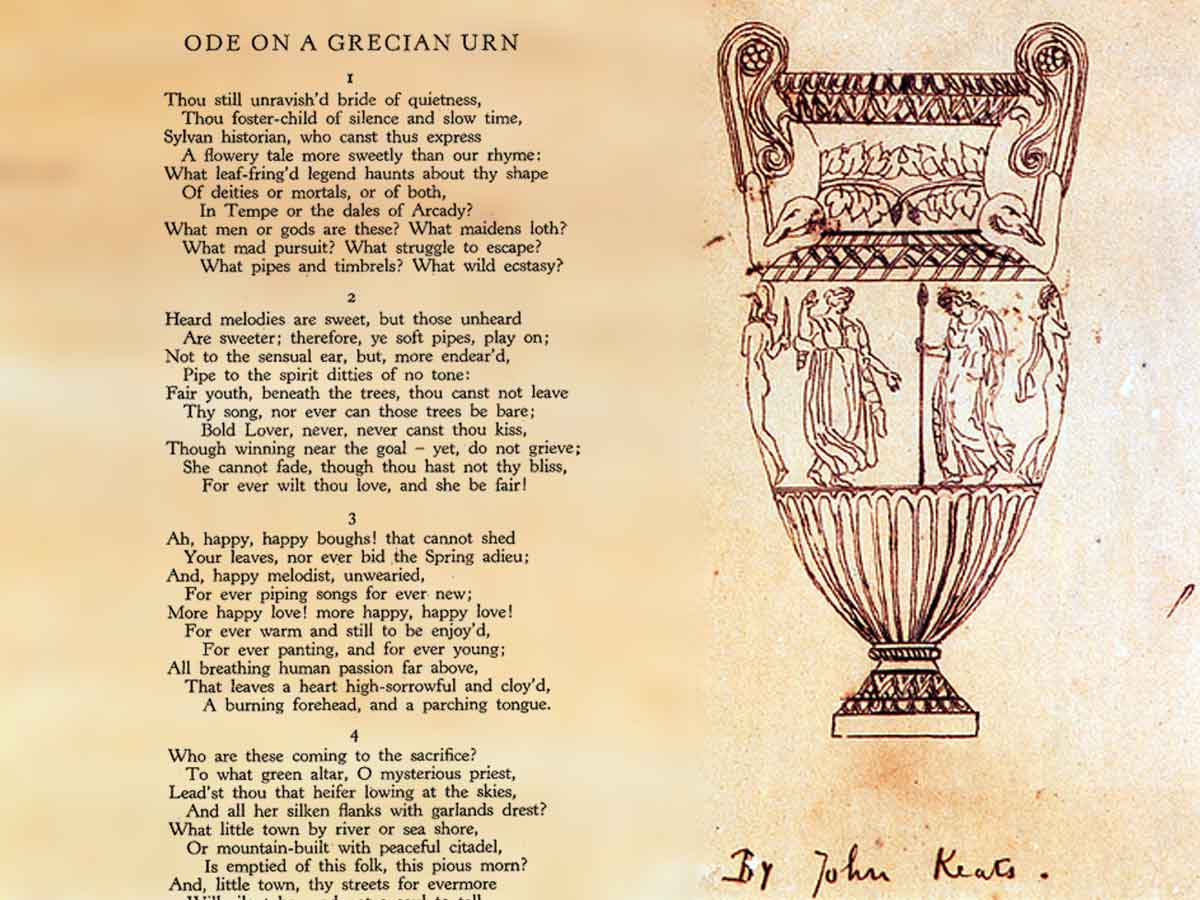This article delves into John Keats’s “Ode on a Grecian Urn,” exploring its key themes, symbolism, and enduring relevance in the digital age. Whether you’re seeking a PDF download of the poem or a comprehensive analysis of its meaning, this guide offers valuable insights into Keats’s masterpiece. [https://www.lolaapp.com/]
Decoding the Urn’s Timeless Message
Keats’s “Ode on a Grecian Urn,” published in 1819 alongside his other renowned odes like “Ode to a Nightingale” and “Ode to Psyche,” [https://www.lolaapp.com/auguries-of-innocence] captivates readers with its exploration of art, beauty, truth, and the human condition. This exploration centers on the intriguing tension between life’s ephemeral nature and art’s permanence, raising profound questions about the essence of experience and the power of imagination.
Why “Ode on a Grecian Urn” Still Matters
This isn’t just an old poem; it’s a vibrant dialogue about what it means to be human. Keats wasn’t merely describing a pot; he was using it as a lens to explore fundamental questions about life, death, and the power of art. The urn, frozen in a single moment, becomes a powerful symbol of art’s ability to transcend time, immortalizing fleeting moments of beauty and passion. This concept resonates even more strongly in our digital age, where images are constantly reproduced and disseminated. [https://www.lolaapp.com/] Does this proliferation diminish their power, or does it, perhaps, amplify the poem’s message about art’s ability to transcend time?
Beyond Summary: Unraveling the Poem’s Complexity
A simple summary won’t unlock the poem’s true power. We need to delve into the rich tapestry of its language, imagery, and symbolism. The figures on the urn—the piper, the lovers, the sacrificial procession—each tell a silent story, inviting us to actively participate in creating meaning. This act of imaginative engagement bridges the gap between the static image and the lived experience, suggesting that the meaning of art isn’t fixed, but rather co-created through the viewer’s interaction. The urn’s frozen narratives challenge our understanding of beauty, truth, and the nature of experience itself. What do these eternally captured moments reveal about the human condition?
Deciphering the Symbolism: More Than Meets the Eye
The urn itself is a powerful symbol of art’s ability to capture and preserve fleeting moments. But within its depicted scenes lie further layers of meaning:
- The Unheard Melody: The piper’s music, though eternally present, remains unheard. This paradox raises questions about the nature of artistic experience. Is imagined beauty more potent than something we can directly perceive? Does the eternal nature of the music enhance its beauty, or does it suggest a poignant incompleteness? [https://www.lolaapp.com/pyramus-beloved]
- The Eternal Lovers: Forever on the verge of a kiss, the lovers embody the tension between anticipation and fulfillment. Their frozen embrace represents a kind of idealized love, untouched by the complexities and disappointments of real relationships. Yet, their static state also prompts us to consider the limitations of such perfection. Could it be that lived experience with all its ups and downs holds more value?
- The Sacrificial Procession: This scene introduces themes of ritual, community, and the unknown. The procession, eternally on its way to a destination we never see, invites us to reflect on the journeys we undertake in our own lives and the mysteries that lie ahead. Some experts believe this imagery suggests a connection between the human and the divine, even within the seemingly static world of the urn.
Enhancing Your Understanding: Resources and Further Exploration
Several resources can enrich your engagement with the poem:
- PDF Downloads: Easily find PDFs of “Ode on a Grecian Urn” online, often categorized by type (e.g., with comprehension questions, academic context). This accessibility allows readers to delve into the poem at their own pace and revisit passages as needed.
- Video Analyses: Engaging video analyses, like those available on YouTube, can offer line-by-line explanations and explore different interpretations.
- Images of Grecian Urns: Viewing images of actual Grecian urns can provide valuable visual context, helping you to appreciate the artistry that inspired Keats.
- Musical Adaptations: Exploring musical adaptations of the poem, such as the one by Gustav Holst, can offer a unique auditory experience of Keats’s words.
Placing the Poem in Context: Keats and Romanticism
“Ode on a Grecian Urn” is a product of the Romantic movement, a period in art and literature that emphasized emotion, imagination, and the beauty of nature. Comparing this ode to Keats’s other works reveals recurring themes and stylistic choices. Keats grappled with profound questions about life, death, and the power of art, themes that become particularly poignant when considering his own struggles with illness and mortality.
Unpacking the Core Themes: A Closer Look
The Paradox of Art and Life
The poem’s central tension lies in the contrast between the urn’s immortality and the transient nature of human life. This juxtaposition prompts us to consider where true beauty resides. Is it in the eternal stillness of art, or in the vibrant, but fleeting, beauty of lived experience?
Beauty and Truth: A Complex Relationship
The famous line, “Beauty is truth, truth beauty,—that is all / Ye know on earth, and all ye need to know,” remains one of the most debated lines in English literature. What did Keats intend by equating beauty with truth? Some scholars suggest that true beauty reveals a profound truth about the universe, while others argue that the only truth we can access is the beauty we experience in the present moment. The ambiguity of this statement invites ongoing interpretation and contributes to the poem’s enduring allure.
The Power of Imagination
The urn’s silent scenes invite the reader to actively imagine the stories unfolding within them. This emphasizes the power of imagination to bridge the gap between the static artwork and the dynamic world of human experience. The speaker’s questions and evolving perspective throughout the poem demonstrate the dynamic nature of this imaginative engagement.
Negative Capability
Keats championed the concept of “negative capability,” the ability to embrace uncertainty and ambiguity without needing definitive answers. This concept is central to understanding the poem. The urn doesn’t offer solutions; it poses questions. It invites us to contemplate the mysteries of art, life, and the human condition, accepting that some questions may not have easy answers.
Ode on a Grecian Urn: A Summary and Starting Point
“Ode on a Grecian Urn” centers on a speaker’s encounter with an ancient urn adorned with vivid scenes of Greek life. The speaker reflects on the urn’s frozen narratives, contemplating the relationship between art and life, beauty and truth, and the passage of time. The poem’s concluding lines, “Beauty is truth, truth beauty,” offer a cryptic and enduring meditation on the nature of art and its connection to human understanding. This encounter prompts reflections on the urn’s immortalized moments, contrasting them with the fleeting nature of human existence and sparking a deeper exploration of what truly constitutes beauty and truth.
This in-depth exploration of “Ode on a Grecian Urn” provides a comprehensive understanding of its intricate layers. Remember, the journey of interpretation is an ongoing one. What does the urn reveal to you?
- Crypto Quotes’ Red Flags: Avoid Costly Mistakes - June 30, 2025
- Unlock Inspirational Crypto Quotes: Future Predictions - June 30, 2025
- Famous Bitcoin Quotes: A Deep Dive into Crypto’s History - June 30, 2025

















2 thoughts on “Ode on a Grecian Urn: PDF Downloads, Analysis, and Scholarly Resources”
Comments are closed.